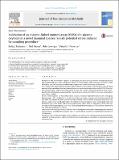Validation of an enzyme-linked immunoassay (ELISA) for plasma oxytocin in a novel mammal species reveals potential errors induced by sampling procedure
Abstract
BACKGROUND: The neuropeptide oxytocin is increasing the focus of many studies investigating human and animal social behaviours and diseases. However, interpretation and comparison of results is made difficult by a lack of consistent methodological approaches towards analysing this hormone. NEW METHOD: This study determined the sample collection and analysis protocols that cause the least amounts of protocol dependant variation in plasma oxytocin concentrations detected by ELISA. The effect of vacutainer type, sample extraction prior to analysis and capture and restraint protocol were investigated while validating an assay protocol for two novel species, grey seals (Halichoerus grypus) and harbour seals (Phoca vitulina). RESULTS: Where samples are extracted prior to analysis, vacutainer type (EDTA mean: 8.25±0.56pg/ml, heparin mean: 8.25±0.62pg/ml, p=0.82), time taken to obtain a sample and restraint protocol did not affect the concentration of oxytocin detected. However, concentrations of oxytocin detected in raw plasma samples were significantly higher than those in extracted samples, and varied significantly with vacutainer type (EDTA mean: 534.4±43.7pg/ml, heparin mean: 300.9±19.6pg/ml, p<0.001) and capture and restraint methodology. There was no relationship between oxytocin concentrations detected in raw and extracted plasma (p=0.25). COMPARISON WITH EXISTING METHOD(S): Over half the reviewed published studies analysing plasma oxytocin use raw plasma and different vacutainer types are used without consistency or justification through-out the literature. CONCLUSIONS: We caution that studies using raw plasma are likely to over estimate oxytocin concentrations, cannot be used to accurately infer true values via correlations and are susceptible to variation according vacutainer type.
Citation
Robinson , K J , Hazon , N , Lonergan , M & Pomeroy , P 2014 , ' Validation of an enzyme-linked immunoassay (ELISA) for plasma oxytocin in a novel mammal species reveals potential errors induced by sampling procedure ' , Journal of Neuroscience Methods , vol. 226 , pp. 73-79 . https://doi.org/10.1016/j.jneumeth.2014.01.019
Publication
Journal of Neuroscience Methods
Status
Peer reviewed
ISSN
0165-0270Type
Journal article
Description
This work was conducted as part of a PhD, which was funded by the Natural Environment Research Council (NERC), UK and by SMRU Marine, St Andrews, UK.Collections
Items in the St Andrews Research Repository are protected by copyright, with all rights reserved, unless otherwise indicated.

